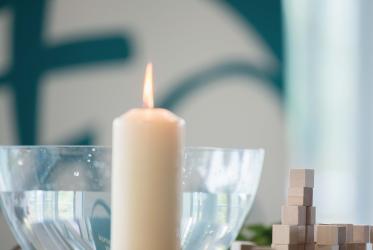Introduction
The Armenian people have a special respect for the holy cross: they call themselves a “cross-bearer” nation. Over centuries, Armenians have carried the cross of Christ with faith, hope, and love. Our people as a nation accepted Christ and relied on the sign of his holy cross, which has always reminded and continues to remind us of God’s victory over death, as well as of his unconditional love for his people.
Visit any medieval monastery in Armenia and you will observe that almost every surface, from the dome to the floor, is covered with carved crosses. Some of them are valuable works of art created by anonymous medieval sculptors, while others are simple engravings made by contemporary pilgrims.
The plan of traditional Armenian churches is cruciform. The cross is installed in the centre of the holy altar. Priests hold the cross in their right hand. Every baptized Christian carries a cross on his or her chest. Vestments and sacred vessels are decorated with crosses. Crosses crown the church domes. During the sacred liturgy, clergymen frequently bless the faithful with the sign of the cross while saying, “Peace be with you.”
Christian Armenians consider the holy cross to be the manifestation of God’s supreme love for humanity, his victory over injustice, sin, suffering, and even death, as well as his desire to make us a part of his divine, eternal life. What once was an instrument of suffering and death has become for Christians the means of salvation and victory.
Indeed, the Armenian Church boasts in the holy cross and its message, in accordance with the words of the holy apostle Paul, “May I never boast of anything except the cross of our Lord Jesus Christ, by which the world has been crucified to me, and I to the world” (Gal. 6:14).
Bible passage: Psalm 85
Prayer for the Restoration of God’s Favor
To the leader. Of the Korahites. A Psalm.
Lord, you were favorable to your land;
you restored the fortunes of Jacob.
You forgave the iniquity of your people;
you pardoned all their sin.Selah
You withdrew all your wrath;
you turned from your hot anger.
Restore us again, O God of our salvation,
and put away your indignation toward us.
Will you be angry with us forever?
Will you prolong your anger to all generations?
Will you not revive us again,
so that your people may rejoice in you?
Show us your steadfast love, O Lord,
and grant us your salvation.
Let me hear what God the Lord will speak,
for he will speak peace to his people,
to his faithful, to those who turn to him in their hearts.[a]
Surely his salvation is at hand for those who fear him,
that his glory may dwell in our land.
Steadfast love and faithfulness will meet;
righteousness and peace will kiss each other.
Faithfulness will spring up from the ground,
and righteousness will look down from the sky.
The Lord will give what is good,
and our land will yield its increase.
Righteousness will go before him
and will make a path for his steps.
Reflection
The Feast of the Exaltation of the Holy Cross, one of the five major feasts of the Armenian Church, is a solemn remembrance of the exaltation of the Lord’s life-giving cross. In the tradition of the church, the holy cross was raised up for veneration three times.
It was first exalted by St James, the apostle and first bishop of Jerusalem. He raised the holy cross in front of the believers while reciting, “We bow down before your Cross, O Christ.” This saying is still used in Armenian liturgical rites.
The holy cross was exalted again about three hundred years later on the occasion of its discovery. In 326 AD, Queen Helena, mother of Emperor Constantine the Great, travelled to Jerusalem to find the true cross of the Lord. Following the miraculous discovery, Queen Helena ordered the Church of the Holy Resurrection to be built on Golgotha, where she raised up the cross of Christ for the veneration of the people.
In the 7th century, the cross was exalted for the third time. After seizing Jerusalem, the Persians captured the cross of Christ. Emperor Heracles, with the help of a large army, eventually liberated the holy cross from captivity. In a solemn procession, the holy cross was moved first from Persia to the Armenian city of Karin, and from there to Constantinople and finally back to Jerusalem. The cross was raised up almost everywhere along its journey, and it was a cause for great joy for all who gazed upon it, for it was as if they were experiencing Christ’s triumphant resurrection. These three historical events resulted in the establishment of the Feast of the Exaltation of the Holy Cross.
The cross on which our Lord Jesus Christ died consisted of two simple fragments of wood attached together, while the Armenian cross is one integrated whole. In a typical Armenian-style cross, the horizontal beam and the vertical beam have become one, fused together seamlessly and permanently by a circle where they meet.
This artistic feature expresses the basic principle of the gospel: the cross of Christ united justice and love; heaven and earth met in it. The King of Glory humbled himself so that we could ascend. God’s only-begotten Son, Jesus Christ incarnated, came into this sinful world to deliver humankind from the bondage of sin and to grant everlasting life.
Here is the power of the cross: God unites his righteousness and love to judge and save sinful humanity. There could be no justice without the crucifixion of Jesus Christ: justice would be only condemnation and punishment. At the same time, there could be no love without the crucifixion. Love would be a simple feeling. For this reason, “He has told you, O mortal, what is good; and what does the Lord require of you but to do justice, and to love kindness, and to walk humbly with your God?” (Micah 6:8).
Justice and love are often perceived as different and even opposite values and goals. On the one hand, justice is presented as severe condemnation or punishment without mercy. On the other hand, love is perceived as a feeling, in which errors and faults are simply ignored without any consequences.
The Bible presents justice and love in a completely different way. Both are an integral part of God’s image. God is a righteous judge (Ps. 7:7; 2 Tim. 4:8) and, at the same time, God is love (1 John 4:8).
The psalmist perfectly presents the union of these two in the presence of God. “Righteousness and justice are the foundation of your throne; steadfast love and faithfulness go before you” (Ps. 89:14).
In the creation of the world, God determined that justice and love should harmonize and strengthen one another. In God’s creation, righteousness is derived from love toward God and neighbour and must seek for the peace of all people. Accordingly, love must seek universal justice and establish peace among people.
However, the world is not what God wants it to be. People sinned and turned away from the natural goodness created by God. Because of sin, humans have neglected, even rebelled against God’s good intentions and established order, thus disrupting their natural life as well as that of the entire creation.
But God did not forsake us in our sinful rebellion. He helped us with his righteousness and love to defeat evil and to heal our diseases and death, which we inherited as a result of sin.
Righteousness and love were united in the cross of our Lord Jesus Christ, in which God’s wrath against sin and his care for humankind met each other. They “met and kissed each other” (Ps. 85:10) in judgment and salvation. God’s only begotten Son suffered and was crucified for us, revealing God’s righteousness and love for us. Therefore, in this sinful world, God’s righteousness and love are identified in the form of the cross, in the crucified Jesus, whose sacrificial love leads the world to righteousness.
God does not ignore errors, evil, and sins. The cross truly and fully executes God’s absolute and holy judgment on sin. As the apostle Paul says, “God put forward [Christ] as a sacrifice of atonement by his blood, effective through faith. He did this to show his righteousness, because in his divine forbearance he had passed over the sins previously committed; it was to prove at the present time that he himself is righteous and that he justifies the one who has faith in Jesus” (Rom. 3:25-26).
At the same time, the cross is the manifestation of God’s redemptive love. “For in him all the fullness of God was pleased to dwell, and through him God was pleased to reconcile to himself all things, whether on earth or in heaven, by making peace through the blood of his cross” (Col. 1:19-20).
And because God is one, righteousness and love are also united in the essence and salvation of God, that is, the cross of the Lord Jesus Christ. Thus, true justice cannot exist without love, nor can true love exist without justice. Justice and love are not contradictory at all, nor are they completely different from each other. In the purposes and nature of God, both justice and love serve the good of people and human relations.
Human existence, in its turn, must reflect the nature and purposes of God. When everything is all right in the life of individuals and communities, justice and love should be the characteristics of that wellbeing. When there are problems in the life of individuals and communities, justice and love should strive to achieve or restore that wellbeing. The challenge for Christians is to live according to righteousness and love in this life so they reflect God’s nature and accomplish God’s purposes in our fallen world.
On the way to meet these challenges, the highly exalted cross of our Lord Jesus Christ reminds us that suffering is necessarily present in the search for true justice and love. Suffering is an inevitable part of this earthly life. It is also an inevitable part of God’s salvation, and for this reason, there is no suffering without hope. It is through them that evil retreats and redemption begins. This truth is revealed by the cross.
Yet, suffering and death never have the last word. Truly, the crucifixion is not the end. The crucifixion is followed by the resurrection. The evangelists present the crucifixion and resurrection as a continuous and united plan of God, by which God defeats sin and grants salvation to the world.
Jesus Christ died so that we could be dead to sin. Jesus was resurrected so that we could be resurrected to a new life. Thus, through the crucifixion and resurrection, we receive a new life in Jesus Christ, overcoming sin and its destructive effects on our relationship with God, with one another, with ourselves, and with all of creation.
The story of God’s justice and love is the story of good coming forth from evil, joy from sorrow, hope from hopelessness, and life from death.
Thus, “hold fast to love and justice, and wait continually for your God” (Hos. 12:6).
Questions for further reflection
- How would you say that justice and love come together and unite on the cross?
- What does it mean for us to be transformed and restored by God’s justice and love?
- How can God’s justice and love transform and restore our lives and the lives of the Christian churches and communities?
- Are Christian churches and organizations uniquely poised and equipped to provide God’s justice and love?
Prayer
Now, look upon me besieged by overwhelming danger,
you who are alone sweet to all.
Cut me loose with your victorious sword of life, the cross,
and release me from the nets that have snared me,
nets that assail me on all sides as the captive of death.
Please steady my shaky feet on the crooked path and
heal the burning fever of my anguished heart.
Turn away the demonic whisper of temptation to sin against you.
Drive away the despair of my dark soul that dwells with evil.
Dispel the thick smoke of sin that has infused and obscured me.
Destroy the vile dark passions of my base needs.
Renew the image of light revered by
the glory of your mighty name, my soul.
Fix your glowing grace upon my face and
the perception of my mind, an earthbound creature.
And cleanse my squalid sinfulness with your purity
so that you might restore and reveal your image in me.
With your divine, living, uncorrupted and
heavenly light that envelopes your three persons.
For you alone are blessed with the Father and Holy Spirit
forever and ever.
Amen.
(Saint Gregory of Narek, The Book of Prayers, chapter 40)
About the author
Rev. Fr Mesrop Parsamyan is director of ministries at the Eastern Diocese of the Armenian Church of America. He is a member of the Brotherhood of Etchmiadzin and was ordained to the priesthood in 2003. After graduating from Gevgorgyan Theological Seminary in 2003 and the University of Strasbourg in 2007, he served as professor of Christian Ethics at Etchmiadzin’s Kevorkian Theological Seminary and as deputy-chancellor of the Mother See. Fr Parsamyan served pastorally in Belgium and France before being appointed locum tenens of the Diocese of Switzerland. From 2012 to 2014, he served in France as vicar general of the Diocese of Marseille, and later as locum tenens of the Diocese of Paris. From 2015 to 2019, Fr Mesrop served at the Eastern Diocese of the Armenian Church of America as pastor of the Holy Shoghagat Church of Belleville, Illinois, and then as vicar of St. Vartan Armenian Cathedral, New York City. From 2019 to 2021, he was dean of Gevorkian Theological Seminary in Etchmiadzin.






